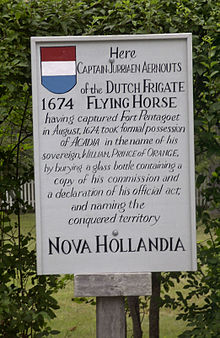
Castine is a town in Hancock County in eastern Maine, United States. The population was 1,320 at the 2020 census. Castine is the home of Maine Maritime Academy, a four-year institution that graduates officers and engineers for the United States Merchant Marine and marine related industries. Approximately 1000 students are enrolled. During the French colonial period, Castine was the southern tip of Acadia and served as the regional capital between 1670 and 1674.

Acadia was a colony of New France in northeastern North America which included parts of what are now the Maritime provinces, the Gaspé Peninsula and Maine to the Kennebec River. During much of the 17th and early 18th centuries, Norridgewock on the Kennebec River and Castine at the end of the Penobscot River were the southernmost settlements of Acadia. The French government specified land bordering the Atlantic coast, roughly between the 40th and 46th parallels. It was eventually divided into British colonies. The population of Acadia included the various indigenous First Nations that comprised the Wabanaki Confederacy, the Acadian people and other French settlers.

Port-Royal National Historic Site is a National Historic Site located on the north bank of the Annapolis Basin in the community of Port Royal, Nova Scotia, Canada. The site is the location of the Habitation at Port-Royal.
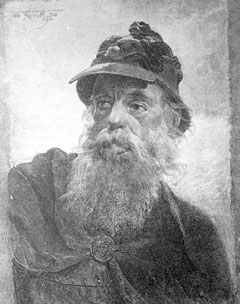
Jean-Vincent d'Abbadie de Saint-Castin (1652–1707) was a French military officer serving in Acadia and an Abenaki chief. He is the father of two prominent sons who were also military leaders in Acadia: Bernard-Anselme and Joseph. He is the namesake of Castine, Maine. He died at Pau, France, in 1707.

The Acadians are the descendants of 17th and 18th century French settlers in parts of Acadia in the northeastern region of North America comprising what is now the Canadian Maritime Provinces of New Brunswick, Nova Scotia and Prince Edward Island, the Gaspé peninsula in eastern Québec, and the Kennebec River in southern Maine. The settlers whose descendants became Acadians primarily came from the southwestern and southern regions of France, historically known as Occitania, while some Acadians are claimed to be descended from the Indigenous peoples of the region. Today, due to assimilation, some Acadians may share other ethnic ancestries as well.
Sir Thomas Temple, 1st Baronet was an English proprietor and governor of Acadia/Nova Scotia (1657–70). In 1662, he was created a Baronet of Nova Scotia by Charles II.
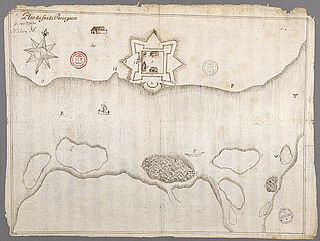
Fort Pentagouët was a French fort established in present-day Castine, Maine, which was the capital of Acadia (1670–1674). It is the oldest permanent settlement in New England.

The Battle of Bloody Creek was fought on 10/21 June 1711 during Queen Anne's War. An Abenaki militia successfully ambushed British soldiers at a place that became known as Bloody Creek after the battles fought there. The creek empties into the Annapolis River at present day Carleton Corner, Nova Scotia, and was also the location of a battle in 1757.
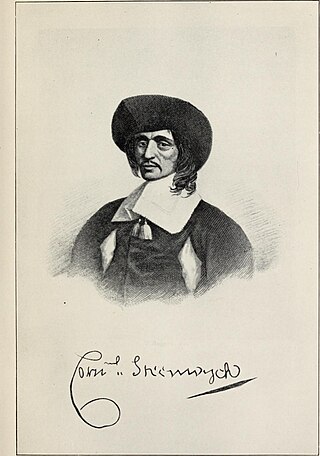
Cornelius Steenwyck served two terms as Mayor of New York City, the first from 1668 to 1672 (or 1670, and the second from 1682 to 1684.

Abbé Jean-Louis Le Loutre was a Catholic priest and missionary for the Paris Foreign Missions Society. Le Loutre became the leader of the French forces and the Acadian and Mi'kmaq militias during King George's War and Father Le Loutre's War in the eighteenth-century struggle for power between the French, Acadians, and Miꞌkmaq against the British over Acadia.

Jurriaen Aernoutsz was a Dutch colonial navy captain, who briefly conquered the capital of Acadia, Fort Pentagouet in Penobscot Bay and several other villages, and renamed the colony New Holland during the Franco-Dutch War.
John Rhoades was a fur trader from New England, who was part of Jurriaen Aernoutsz's short-lived conquest of Acadia in 1674.
Port La Tour is a community in the Canadian province of Nova Scotia, located in the Municipality of the District of Barrington of Shelburne County.

The siege of Pemaquid occurred during King William's War when French and Native forces from New France attacked the English settlement at Pemaquid, a community on the border with Acadia. The siege was led by Pierre Le Moyne d'Iberville and Baron de St Castin between August 14–15, 1696. Commander of Fort William Henry, Captain Pasco Chubb, surrendered the fort. Iberville killed three of the soldiers and sent the other 92 back to Boston.

The siege of Pemaquid was a successful attack by a large band of Abenaki Indians on the English fort at Pemaquid, Fort Charles, then the easternmost outpost of colonial Massachusetts. The French-Abenaki attack was led by Jean-Vincent d'Abbadie de Saint-Castin and Father Louis-Pierre Thury and Chief Moxus. The fall of Pemaquid was a significant setback to the English. It pushed the frontier back to Casco (Falmouth), Maine.
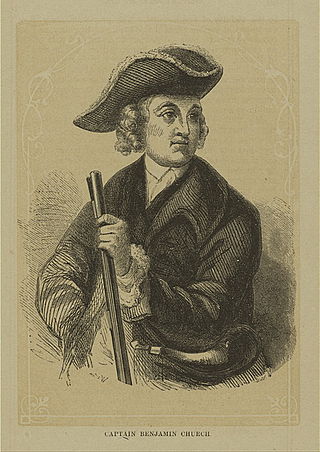
The siege of Fort Nashwaak occurred during King William's War when New England forces from Boston attacked the capital of Acadia, Fort Nashwaak, at present-day Fredericton, New Brunswick. The siege was in retaliation for the French and Indian Siege of Pemaquid (1696) at present day Bristol, Maine. In the English Province of Massachusetts Bay. Colonel John Hathorne and Major Benjamin Church were the leaders of the New England force of 400 men. The siege lasted two days, between October 18–20, 1696, and formed part of a larger expedition by Church against a number of other Acadian communities.

The Acadian Civil War (1635–1654) was fought between competing governors of the French province of Acadia. Governor Charles de Saint-Étienne de la Tour had been granted one area of territory by King Louis XIV, and Charles de Menou d'Aulnay had been granted another area. The divisions made by the king were geographically uninformed, and the two territories and their administrative centres overlapped. The conflict was intensified by personal animosity between the two governors, and came to an end when d'Aulnay successfully expelled la Tour from his holdings. D'Aulnay's success was effectively overturned after his death when la Tour married D'Aulnay's widow in 1653.

Port-Royal (1629–1710) was a settlement on the site of modern-day Annapolis Royal, Nova Scotia, part of the French colony of Acadia. The original French settlement of Port-Royal (Habitation de Port-Royal had earlier established farms in the area.
Cornelius Andreson was a Dutch pirate, privateer, and soldier. He is best known for attacking English traders off Acadia and for serving in King Philip’s War.
Peter Roderigo was a Dutch pirate, privateer, and soldier. He is best known for attacking English traders off Acadia and for serving in King Philip’s War.
